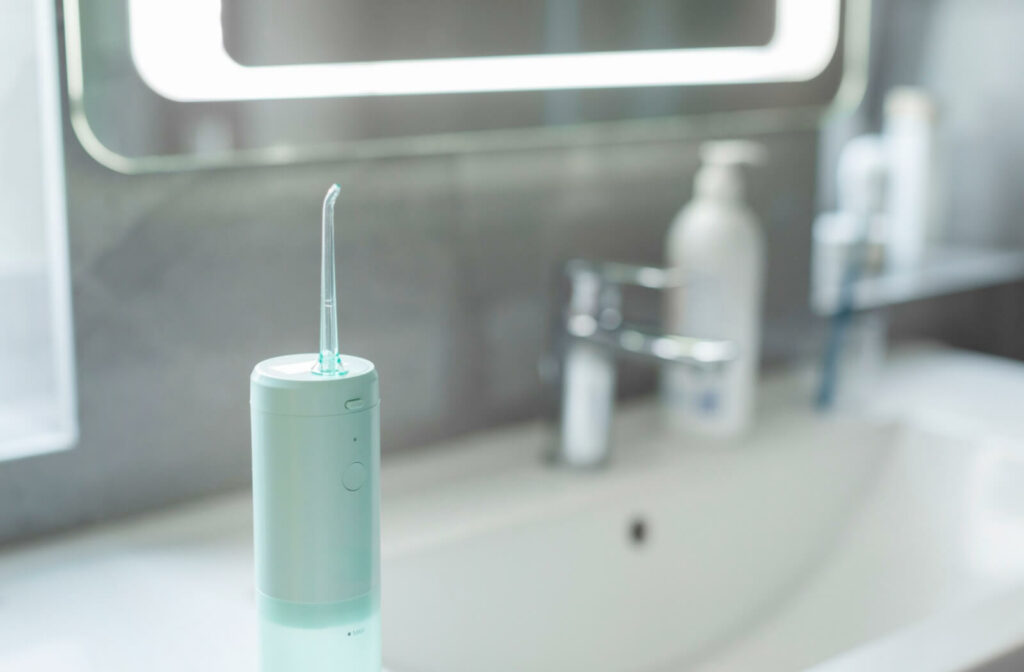You brush your teeth twice a day, but what about the spaces between them? Plaque and food particles can hide in these tight spots where your toothbrush can’t reach. The risk of food getting stuck between your teeth is why dentists recommend flossing at least once daily.
Another oral hygiene tool that can be helpful in this area is a waterflosser. But a Waterpik isn’t as good as flossing and shouldn’t replace it in your hygiene routine. String floss should still be your primary tool for ensuring nothing is trapped between your teeth that could cause tooth decay.
What a Water Flosser Does for Your Smile
A water flosser is a handheld device that uses a targeted stream of pulsating water. You aim this stream between your teeth and along your gumline. This action helps to wash away loose food particles and plaque from the surfaces of your teeth.
Benefits of a Water Flosser
It can be a helpful option if you have dental work like braces, bridges, or implants. These can make using string floss more challenging. The water stream can navigate around them with ease.
The water can also feel gentle on your gums, especially if they are sensitive. You can often adjust the pressure setting for your comfort. It can also flush out debris from hard-to-reach areas.
Drawbacks of a Water Flosser
A water flosser primarily rinses your teeth and may not remove plaque as effectively as manual flossing. It also takes some practice to use without spraying water around your bathroom. The device itself requires counter space and needs access to an electrical outlet.
The Role of Traditional Dental Floss
Dental floss is the long-standing tool for cleaning between teeth. By guiding a thin string into the areas your toothbrush can’t reach, you physically scrape away buildup. This manual cleaning helps disrupt plaque before it can cause issues.
Why Floss Is a Go-To Tool
Floss makes direct contact with the tooth, which is very effective for plaque control. This physical wiping motion removes the sticky film that can accumulate during the day. You have complete control over the pressure and placement.
It’s also portable and convenient. A small container of floss fits easily in a pocket or bag. This portability makes it simple to maintain your routine wherever you are.
Common Floss Frustrations
Getting the technique right can take practice, especially for reaching the back molars. Some people also find it challenging to guide floss between crowded teeth. If you apply too much pressure, you might irritate your gums, so a gentle approach is always helpful.

Get a Personalized Oral Health Plan
Your mouth is unique, and the proper cleaning routine for you depends on your specific dental health needs. The Canadian Dental Association (CDA) emphasizes that factors like tooth alignment and existing dental work can influence which tools are most effective. A professional can help you build a routine that works for you.
A thorough and empathetic approach means your comfort and health are always the focus. Our team at Belman Dental Centre can demonstrate proper techniques for any tool you choose during your next appointment.
If you’re ready to dial in your flossing routine, book an appointment to discuss your oral health goals with the team.
Should You Replace String Floss with a Water Flosser?
For most people, a water flosser works alongside string floss instead of replacing it entirely. The 2 tools perform different jobs. Floss is for scrubbing away sticky plaque, and a water flosser is for rinsing away what’s left.
Use Them Together for a Deeper Clean
Combining both tools can give you a very thorough clean. This 2-step approach addresses both sticky plaque and loose debris. Many people find this method leaves their mouth feeling exceptionally fresh.
First, follow the CDA’s proper flossing techniques to scrape away and loosen plaque. Then you can use the water flosser to flush out everything between the teeth. Brushing is typically the final step to polish your teeth.
Your At-Home Routine Questions Answered
The most valuable routine is the one you can stick with every single day. Consistency is the key to long-term oral health. Your dental team here is always available to answer any questions you may have.
Which Should Come First: Brush or Floss?
The important thing is that you do both every day. Some find that flossing first helps clear the way for toothpaste. This preparation from the floss can help the fluoride better reach the surfaces between your teeth during brushing.
Discuss Your Questions About Flossing with Us
Your at-home oral care is a key part of your overall wellness. If you have questions about which tools are right for you, you can always ask at your next appointment. The team at Belman Dental Centre is committed to helping you maintain a healthy smile for life.
We’ll support you with personalized care and professional advice. Let’s work together on your oral health. Book an appointment today.



